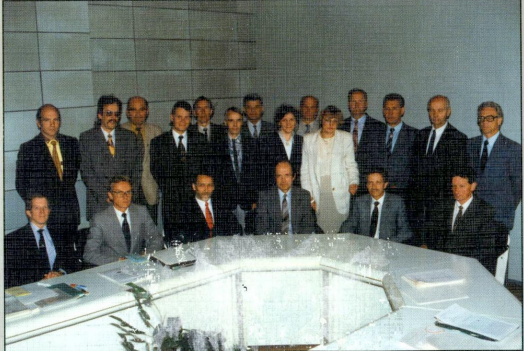Citas ziņas sadaļā
Evaluation of Environmental and Economic Performance of Crop Production in Relation to Crop Rotation, Catch Crops, and Tillage
Assessment of carbon dioxide emissions from different tillage systems
Shrinking governance. Economical aspects in Latvian case
Improving of Small Farm Market Capability in Latvia
The Role of Agribusiness in Maintenance of Future Rural Employment in Latvia
Competitiveness of Latvian Agri-business in Regional Context
Iedzīvotāju labklājības attīstība kā tirgus ietilpības prognozēšanas faktors (uz Latvijas stādu tirgus piemēra)
Economic Analysis of the Value Adding Chain in Milk sector
Different CAP support systems - evaluation of the impact on supply of agricultural products
Efficiency analysis of agricultural sector in Latvia compared to other EU countries, based on FADN data
Zin.publikācijas
Course of Development of Privatization of Join-stock and Limited Liability Companies in 1992Visvaldis Pirksts, Latvijas Valsts agrārās ekonomikas institūts (LVAEI)
31.05.1993 Roberts Zīle report in Finnish-Baltic Joint Seminar, Saku, Estonia, published in 'Agricultural Development Problems and Possibilities in Baltic Countries in the Future' (1993) Agricultural Economics Research Institute, Finnland, ISBN 952-9538-35-9, ISSN 0788-5393, pages 48-51 Oriģinālajā salikumā lasāms PDF fails pielikumā COURSE OF DEVELOPMENT OF PRIVATIZATION OF JOIN-STOCK AND LIMITED LIABILITY COMPANIES IN 1992 ROBERTS ZILE
During this stage a shareholder of a company could alianate, by paying with his shares, any single or combined item from the inventory list he wished to acquire (see Figure 2.). The shareholders could also freely trade their shares among themselves. Within a month's time after public notification other shareholders could also apply for the same objects, and often the new owner was determined in the auction (see Figure 1.). The company had no rights whatsoever to alienate the object for actual privatization. Thus by October 1992 about 15% of companies' assets were actually privatized. According to unofficial estimates by Statistics Committee, by January 1,1993, 25-30% of companies' assets might already be privatized. By October several companies had undergone liquidation, and the large enterprises had ceased to exist as legal entities. The agricultural producers in these pagasts are individual full-time farmers, part-time farmers, service enterprises on cooperative basis (mechanical stations, grain-driers etc.) owned by farmers, as well as some limited liability companies owned by few members. In most cases the latter are the owners of middle-size livestock-farms. There have been some instances when from the large livestock-farms empty buildings remain and livestock is sold separately, but this can be explained by the decrease in purchasing power of population; and it is difficult to sell agricultural products at the price that would cover production costs. The objective of the former collective-farm privatization law was, starting from July1, 1991, to distribute the production units and other assets of these large enterprises between individual farmers, other entrepreneurs and farmers' cooperative service associations. This was planned to happen within 2 to 5 year period, and would entirely change the structure of agricultural production in Latvia. The main principle to be pursued during this process was to encourage and accelerate private entrepreneurship in each pagasts. An effort was made to preserve the production potential (the large livestock-farms, mechanical workshops etc.) of the former collective farms. Much attention was paid that the principles of social justice and publicity be observed.
Since July 1,1991, the course of events was influenced by: 1) The procedure of land reform, which slightly changed due to changes in the political situation. In general, this slowed down a little the pace of privatization of collectivefarm assets; 2) The rapid growth of inflation rate in the period from December of 1991 to December of 1992 (there are no official data available , but for agricultural inputs the prices have increased 50 to 100 fold). This definitely accelerated the privatization process: the shareholders, under a psychological stress, were compelled to obtain property with their shares. The prices, of course, rised respectively; 3) The changes in economic environment due to market development: free prices, the change of price structure between different groups of commodities, a chaotic government protectionism in agriculture etc. Ali this slowed down the privatization of collective-farm assets, because ali the agricultural producers found it difficult to market their products (the demand for Latvian foodstuffs considerably decreased in Russia and in other CIS countries); 4) The pace of actual privatization in agricultural production was much quicker than the pace of privatization in its input and output enterprises and in trade. This was of adverse effect to privatization because a private entrepreneur, and, above ali, an individual farmer, had to face state monopolies (the privatization of input and output enterprises noticeably moved from the standstill at the end of 1992); According to yet unofficial statistical data by the end of 1992, the number of livestock in Latvia has decreased if compared to the 1991 data. In 1992, there are : We have drawn conclusions that the following circumstances, enumerated according to their sequence, influenced this development. 1) The marketing problem caused by the increase of price to agricultural products, the loss of Eastern markets. It might be worthwhile to remind that during the period of centralized planned economy the following flow-chart worked in Latvia: imported concentrated feed - meat export. When the system collapsed, difficulties with feed for pigs and poultry appeared. 2) State processing enterprise and the lame attempt to "liberalize" prices. Combined with the awkward payment system and banking system, it caused a 2 to 6 month delay in payments to farmers and agricultural production companies for their products. 3) The high price the state paid to grain-producers, which in 1992 created a situation that 4) Privatization of joint-stock companies' and limited liability companies' assets, which like any structural change, at the first moment causes a decrease in production. Anyway, a decrease to such extent in livestock production is not dramatical for Latvia. This means that the structural and ownership changes in Latvia are not put in jeopardy. The future projections for privatization in agriculture might be as follows Figure 3. Ratio of private property in branches of agribusiness.
|


